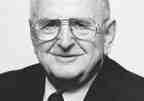A hundred years of mining were distilled into a few hours at the fifteenth annual induction ceremony and dinner of the Canadian Mining Hall of Fame in Toronto on January 16.
In the hundredth anniversary year of the discovery of silver at Cobalt, Ont., the Hall of Fame inducted four of the discoverers of the Cobalt deposits, James McKinley, Ernest Darragh, Fred LaRose, and Tom Hbert.
McKinley and Darragh were the first to discover silver mineralization at Cobalt, while looking for lumber for the Timiskaming and Northern Ontario Railway (T&NO, now the Ontario Northland), which was being built to New Liskeard from the end of the Grand Trunk in North Bay. Noticing pink stains on a rock, they knocked off a few samples and — putting into practice something they had learned while prospecting in California — bit the metallic minerals to find that some of it was soft native silver. An assay laboratory in Ottawa found only bismuth; the laboratory at McGill University, under the direction of chemist Milton Hersey, found 4,000 oz. silver per ton.
Legend has it that LaRose, a blacksmith working for the T&NO, threw a hammer at a fox while sharpening drill steels. The fox dodged in time, but LaRose noticed pink staining on the rock and thought it might be cobalt bloom, prompting master of ceremonies Pierre Lassonde, president of Newmont Mining, to observe that many geologists still work in that random way today.
LaRose’s samples were sent to Toronto, where a lab found nickel. On later examination the Provincial Geologist, Willett Miller, showed it contained cobalt. “So in Ottawa, they found bismuth, in Montreal, they found silver, in Toronto, they found nickel, and then the Ontario government said it was cobalt,” said Lassonde. “We’ve seen that from labs ourselves.”
LaRose and his boss, Duncan McMartin, each staked claims covering the area around LaRose’s new showing; LaRose ultimately retired to his home town of Hull, Que., on the $30,000 paid him by the Timmins brothers for his claim.
Hbert, who was also from Hull, had a similar story — while working for the famed Ottawa lumber baron J.R. Booth, he heard there were jobs on offer with the railway. On the walk over to Long Lake, on the T&NO line, he too noticed nickel and cobalt staining on the rocks. Hbert hiked up to Haileybury with a few samples, showing them to local innkeeper Arthur Ferland. Hbert, Ferland and several friends staked the area, and Hbert, too, retired on his payoff.
Sean Boyd, president of Agnico Eagle Mines, presented the Hall of Fame medals to Reg Holdsworth, chairman of the Cobalt Mining Heritage Committee, and to Pat Anderson, chairwoman of the Northern Ontario Mining Museum, which is located in Cobalt. Anderson thanked both Placer Dome and Agnico Eagle Mines for financial contributions to the Cobalt centennial celebrations, and invited attendees to come visit Cobalt for the Miners’ Festival — and since accommodation may be fully booked, to “bring your sleeping bag.”
The evening was also marked by the unveiling of a new silver dollar by the Royal Canadian Mint, commemorating the Cobalt silver discoveries. Minister of Transport David Collenette led a team equipped with prospector’s picks and crack hammers in demolishing a “rock” covering a mockup of the new dollar, which will be the first Canadian silver dollar to be made from fine, rather than sterling silver.
Neatly, the evening’s three other inductees each represented one of the industry’s technical professions — mining engineer and operational innovator Richard Ennis, geologist and explorationist James Gill, and metallurgical pioneer Vladimir Mackiw. Ennis, for 38 years the manager of the McIntyre gold mine in Timmins, was recognized for his stewardship of what was originally an exceptionally difficult mine, one that Ennis turned into a showcase of technical competence and business success.
Clare Gaudet, a senior vice-president of the Toronto Stock Exchange, presenting the inductee’s medal to Ennis’s niece, Jean Pataran, said Ennis’s interests and achievements in health and safety while at McIntyre marked him as “a man ahead of his time.”
Accepting the award, Pataran noted that her uncle had been “a firm believer in giving back to the community,” most of all in the building of the McIntyre Community Centre in South Porcupine, which was for many years the focal point of social life in the Timmins area.
Geologist James E. Gill, who mixed an academic career at McGill University with a successful geological consulting business, was hailed for his inspirational and challenging leadership to four decades’ worth of geologists. His 1929 discovery, with William R. James, of the iron ore deposits of the Labrador Trough, was one of the first air-supported mineral exploration projects ever undertaken.
Wallace MacLean, a professor emeritus of geology at McGill and a leading researcher in economic geology himself, noted that Gill attracted graduate students because “they wanted to work with a person who had worked in the industry and was practical as well as scientific,” and praised him as “a pioneer in everything he did.”
Gill’s son Robert, who accepted the award, said “I can’t add anything about his mining career, because he was away all the time when I was a kid,” but recounted a story of Gill’s arrival home after a spell of fieldwork with one pack full of rocks and another full of dirty laundry, which he straightaway distributed over the living-room floor.
Last to be inducted was metallurgical chemist Vladimir Mackiw, whose career with Sherritt Gordon Mines embraced the development of hydrometallurgical leaching technologies for nickel and cobalt, and many innovations in extraction processes for other metals, including gold and copper.
Lassonde, making note of how Mackiw’s work in powder metallurgy produced the alloy now used in one-dollar coins, said “I think it’s a cruel joke to have your legacy called a loonie.”
Ian Delaney, chairman of Sherritt International, said that for ten years Mackiw had an office a few steps from his own, and became “an advisor, a confidante, an educator, and a friend,” and that he was thankful for “the trouble he kept me out of for ten years.”
Mackiw’s daughter Christine said her father would have wanted to share the honour with his Sherritt co-workers and with his wife Diana; the widespread adoption of Sherritt technologies around the world, she said, “was due in no small measure to the five-course meals my mother used to create at the Fort [Saskatchewan], where she was regularly called upon to entertain international companies who visited Sherritt.”
She also gave an example of her father’s metallurgical mind: “when it came time for me to marry, he prepared a flowchart.”



Be the first to comment on "From foxes to flowcharts Hall of Fame inductees run the gamut of the mineral industry"